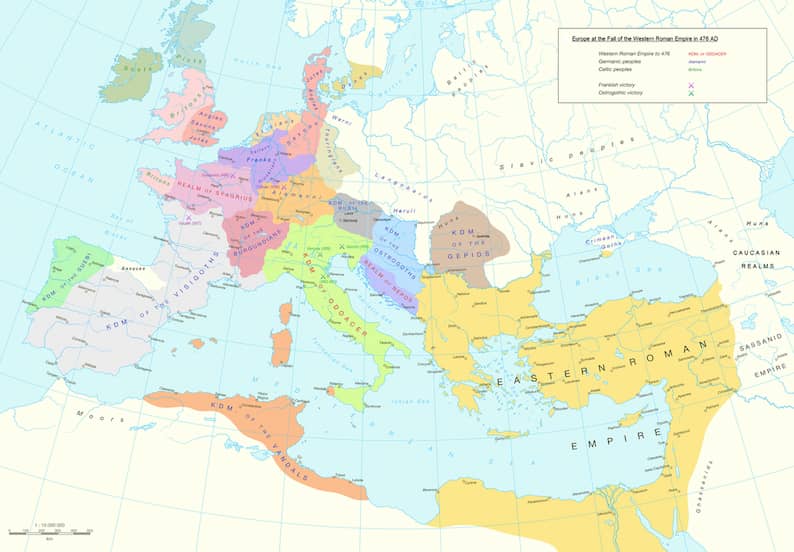So much is known about the Vikings and their explorations across Europe. Yet, even though there’s evidence of relations between Vikings and Germanic tribes, there’s some disagreement amongst historians about whether it’s accurate to talk about German Vikings.
If you want to learn more about the link between Germanic tribes and Vikings, you’re not alone. Research shows that there are two ways to link the two: through archeological evidence and linguistically.
To understand how far back this confusion goes, you should read on to learn about how Vikings and Germanic tribes are linked.

Table of Contents
Were there German Vikings?
Vikings were originally from the Scandinavian region of Northern Europe. These places include present-day Denmark, Sweden, and Norway. Later, Vikings ventured towards the northern borders of modern Germany, particularly, around Hedeby and Sliasthorp, and this resulted in later discoveries of German Vikings in certain parts of Northern Germany.
By the time the Viking Age started, Germanic tribes had long settled in Europe. What followed after is that some of these people decided to join the Viking seafarers as they explored Europe. One can argue that this means that German Vikings did exist in some parts of Europe.
The problem is that when Vikings that came from other regions of Scandinavia settled in parts of Germany, it became difficult to separate the two over time. Germanic tribes who had their own ethnicity ended up being influenced by Viking traditions. For instance, around the 11th century when Christianity took over the north of Germany, it was discovered that the majority of the people in that region had been converted to Native Norse paganism around the Viking Age.

At the peak of the Viking era, there’s a lot of evidence of them scattered in the northern parts of Germany. So, it goes without doubt that there were Germans who decided to become Vikings and follow their way of life in these parts. As tradition would have it, Viking culture was also passed down to their offspring.
It’s important to note that even though there were some German Vikings, it doesn’t mean that they had cultural connections to all other Germanic groups. This is where the confusion can come from. Technically, Vikings raided tribes without any regard of whether they had shared ancestry or not.
What were German Vikings called?
Vikings were known by different names in relation to the area where they were located. In Germany, Vikings were called Ascomanni which was a term used to refer to what the German tribes identified as “ashmen”. This is presumably derived from some Viking ships being made from ash wood.
Originally, the exonym Ascomanni is an ancient term used to describe a pirate. It was used by an Obsidian known as Volsung Fà. The Germans later adopted this as a German Viking name due to the ash wood that Vikings used to build their boats.
However, German Vikings had a lot of names that they went by. Besides being known as Ascomanni, they were generally called Norsemen. However, historical research highlights that the Norse were a branch of a bigger Germanic ethnicity.
You may also be interested in: Did Black Vikings Ever Exist?
Were there Viking settlements in Germany?
Yes, there were Viking settlements in Germany. In fact, Vikings didn’t just settle in Germany, but they conducted a lot of raids on the land along the Rhine River. These raids moved far along the North Sea Coast to the borderlands of Scandinavia.
Archeological findings place Viking settlements around various parts that even include the Netherlands. For example, there was a huge influence by Vikings around Frisia and Noord-Holland. This means that these settlers were part of the then Frankish Empire which is considered modern-day Germany.
The Frankish Kingdom was a large part of the Western region of Europe. It was primarily the Danish Vikings that ended up as settlers in this Empire. Evidence suggests that these famous Vikings focused on their settlements from 860 CE.
There’s been archeological evidence of forts and settlements that were built by Vikings along the Danish border. These were also used as outposts for later invasions. The most recent evidence of Viking settlements in Germany is a powerful city that was excavated in 2012.

The archeological discovery of this city not only proved that there were
Viking settlements in Germany, but that Sliasthorp was a very powerful city at that time. Most importantly, it also helped to shift the view that historians had about Vikings. For instance, there’s a strong belief that there were stark class divisions.
Evidence suggests that this city would have been the size of 50 football pitches. The anatomy of the city strongly suggests that the lower class craftsmen and traders were in one part while the elite were found on the other side of the town.
Did Vikings invade Germany?
Yes, the Vikings did pillage modern-day Germany. Evidence suggests that the most noticeable of these invasions was in the Rhineland region. This has been recorded to have involved several repeated invasions that occurred around the 9th century.
The reasons behind the invasions are most uncertain. In most cases, Viking invasions and raids were aimed at the undefended. There are some reasons that have been debated by scholars for why Vikings decided to invade Germany:
- Their population was under pressure and they needed more resources to sustain the numbers.
- Climate change played an impact in where they needed to move.
- Their homelands had dwindling resources.
- Germany consisted of several wealthy kingdoms/principalities that had much to offer the Vikings.
- Internal conflicts.
- A need to expand their trading routes.
The Germanic tribes had powerful armies that fought through different types of invasions. The invasion of Germany by the Vikings wasn’t an easy feat. In fact, the evidence is clear that the Vikings couldn’t entirely conquer what is now Germany.
Instead, they devised a system that would bring a unified front once they settled after their invasion. They were allowed to freely leave to explore other parts of Europe and return to their settlements after the invasion.
Did the Vikings ever conquer Germany?
Evidence suggests that the Vikings didn’t conquer Germany because too much of it is located inland. As seafaring warriors, the Vikings often struggled to conquer lands located too far from the sea, especially as their ships were generally the bases from which raids were launched.
Much like when Vikings in Finland tried the same thing, the Vikings were notorious for their seafarer escapades and thus struggled to stay within the inland confines for too long. Eventually, they left to explore other parts of Europe even though sources state that they invaded and conquered Germany more than once.

Evidence pinpoints to the fact that the Germans came up with a system to avoid being conquered by the Vikings. Since the raids and invasions grew more dangerous for the Germans, they devised a plan to try and keep the Vikings at bay. They opted to negotiate to pay the raiders in hopes that it would make them go away.
Unfortunately, the Germans ended up with more Vikings that wanted to be paid off than they had bargained for. The raids carried on for a couple of years until they ended around 884 CE. Nordic rune inscriptions point to the fact that some German tribes adopted the Viking way of life around this period, with at least some Viking DNA in Germany remaining due to interactions between the two.
You may also be interested in: 9 Most Famous Swedish Vikings in History
What did the Vikings call the Germans?
In the Viking Age, the Germanic people were called by different names. The names differed by culture and their location. When the Vikings settled in the Germanic region, there were various names that arose, particularly, Normans, Norse-Gaels, and the Rus.
While there were different names for Germanic people by the Vikings, it was common for them to be grouped together and referred to as the Norsemen. Long before the Viking invasion, Germany was inhabited by the Celts. These are said to be peoples from a mixture of tribes that were found along the Baltic Sea Coast.
The Norsemen were distinguished by their language. They still spoke the Old Norse language that the Vikings spoke before but had moved away from. Scandinavian Vikings preferred to use this term to highlight that they were different from the Germans.
Are Vikings a Germanic tribe?
No, Vikings aren’t a Germanic tribe. The fact of the matter is that Germanic tribes consisted of an umbrella of various tribes that speak different languages commonly grouped together. Moreover, Vikings were only a subgroup of different peoples that included the Germans.
The Germanic tribes have their rich history before the Viking invasions and settlements happened. Research demonstrates that the Germanic tribes first originated from Indo-European tribes. These tribes, like many others around the 18th century BC, migrated and spread across parts of Europe.

The Germans chose to move down towards what we now know as Denmark and Sweden. Within the Germanic tribes divisions occurred and there were Balts and Celts as a result. The Balts settled along the Baltic Sea Coast while the Celts chose to move further west towards France.
The reign of the Roman Empire forced the Germanic tribes to move again and to form different confederations (although this was still well before the Viking era, so don’t expect any stories of Vikings vs Romans battles). This is when they settled along the Rhineland region, Danube, as well as the Black Sea. The most significant of the Germanic tribes from the late fourth century are the Franks.
Not only did the Franks defend the imperial borders of Germanic peoples, but they also made a significant impact on the Vikings as they invaded Germany. There was a historical struggle for power and the Franks made history when they did all they could to defend their territory.
You may also be interested in: What Did The Vikings Look Like?
Germanic tribes vs Vikings: What’s the difference?
The main difference between Germanic tribes and Vikings is that Vikings spent most of their lives at sea. The Germanic tribes, on the other hand, were much more land-based. While they took advantage of rivers located throughout modern day Germany, these did not define them.
In addition, unlike with Germanic tribes, the term Viking didn’t describe ethnicity. The term “Germanic tribes” often refers to people whose ethnicity can be traced back to Indo-European origin. They are often identified by certain characteristics such as their ethno-linguistics. They use various languages that originate from Proto-Germanic languages around the Pre-Roman Iron Age.
The term Germanic tribes comes from Roman scribes who used it to define the people who were located in different parts of Greater Germania as it was called before the Viking Age. The Romans studied these tribes to detail the impact that they had as they played a significant role in the vanquishment of Roman legions. After this era, there was further expansion down south that forced these tribes to settle along Central Europe.

As this expansion took place, different groups of Germanic tribes were observed. In addition to this, each group employed its distinct dialect that shared similar language connotations and innovations.
As more expansion took place, settlement patterns were established. The main ones were the need for a solid base and agricultural resources. Although war and conquest destabilized the Germanic tribes, they had a strong military that was fierce in battle.
Conversely, Vikings weren’t an identified ethnicity. They were a group of Scandinavian tribes that had come together to create a legacy. They were mainly explorers who were known for many things such as trade and barter techniques.
To be a Viking, you would’ve been born a natural risk-taker. They were initially a minority group that moved from town to town. As time passed, more people joined the pillage.
The Vikings were now on a quest to colonize cities and smaller towns or villages. They sailed and raided Europe. Where they conquered, they would convert locals into their beliefs and value systems.
A notable difference between Germanic tribes and Vikings is that the former migrated in search of a place to settle in. On the other hand, the Vikings behaved like pirates and tyrants that took part in raids and invasions for dominion over settlements.
Both Vikings and Germanic tribes used different terms for one another. These were often derived from the differences that both groups had. Although they learned to assimilate and share resources, the differences between them were still evident.
Are Germans Nordic?
This is an inconclusive debate due to the fact that research often relies on the exception to Germanic borders to determine the answer. For the most part, Nordic countries are considered to be mainly Denmark, Sweden, and Norway. This means that when you look at it from a country scale, Germans aren’t Nordic.
Firstly, it’s crucial for you to understand what is meant by Nordic. Nordic is a Latin derived term that loosely translates to Northern. But, it’s a term that is used to describe cultures and people who are located in the northern parts of Europe.
The main characteristics of these countries is that they share similarities such as history, culture, and values among others. Since Germanic tribes migrated a lot from the north of Indo-Europe, there has been an inconclusive debate on whether Germans are considered Nordic or not. However, many historical sources agree that Germans are in fact Nordic.

The fact of the matter is that when Germanic tribes settled in the Scandinavian region, they were considered part of the Nordic race. Yet, there are still those who argue against Germans as being Nordic. The argument rests on the fact that Germans differ in physical characteristics when compared to the people who inhabit the Nordic region.
Another difference is highlighted in the language that the Germans use when compared to the people of Denmark, Finland, and Iceland for instance. Even in modern times, these countries are still referred to as Scandinavian. The fact is that these Nordic countries have maintained the status quo of close cooperation that was established by the Viking Age.
Even though the Germanic tribes had assimilated into Nordic tribes and used the same language, the same can’t be said for the Germans of today. Germans speak a language that is derived from west Scandinavia instead of the North. This makes it difficult to determine whether Germans are Nordic or not.
Experts argue that by virtue of the assimilation by the migrated Germanic tribes, it should follow that Germans did adopt the values of Nordic tribes that make them one and the same thing. This means that there isn’t a definite answer to say whether Germans are Nordic or not.
